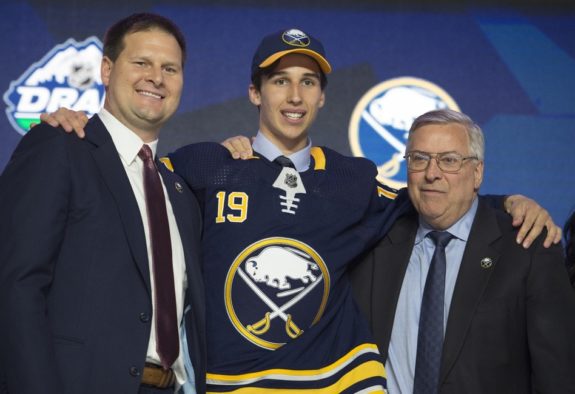“The Buffalo Sabres are pleased to select from Whitehorse and Lethbridge of the WHL…Dylan Cozens.”
With those words, general manager Jason Botterill welcomed the newest Sabre into the fold. Cozens has already set records and hasn’t even played one second of hockey that counts for the Sabres.
Traditional wisdom dictates that unless he was drafted with one of the first three picks of the draft, any 18-year-old should be given at least one season to develop before plunging into the cold, dark waters of the NHL.

Occasionally, a prospect will impress enough that they earn a roster spot right out of camp. Players will then be given nine games to prove their worth and that they deserve to stay with the big club all season. If they play their 10th game, they will have burned year one of their contract and thus only have two seasons remaining on their rookie deal. With that being the case, most rookies will be sent back to their respective junior teams after nine games for more seasoning.
With Cozens, the Sabres could have a potential case for keeping their prospect beyond the nine-game mark. As long as things are handled properly, this could be the best thing for his potential as well as the Sabres’ organization.
Cozens Has the Tools to Succeed
Cozens finds himself at the top of the heap of Sabres prospects. His blend of size, speed and skill make him a rare breed and a perfect fit for today’s NHL. Standing 6-foot-3 and weighing 185 pounds, he has room to grow but currently has the bulk needed to withstand the rigours of an NHL campaign.
Cozens’ style is very simple. First, gain the puck in your zone. Second, take it and head due north. Third, gain the offensive zone and make things happen.
Playing east-west is not how Cozens is programmed. He won’t dipsy-doodle or toe-drag himself around the rink. His game is based on puck possession and driving offence. Given his size, reach and strength, he is able to employ his strengths to take advantage of mismatches against smaller defenders.
Although a small sample size, Cozens’ possession-driving game has been on full display during the preseason. He has been tenacious on pucks, not being afraid to engage physically when required. His composure on offence has been noticeable and he’s earned more playing time. The collective eyeballs of the organization want more opportunity to assess what more Cozens can do.
With each game, Cozens is becoming noticeably more comfortable. As he continues to build confidence and produce more offence, he will be a much more useful player and will develop traits that will serve him well throughout his career. If he can continue to prove he has the goods, he should keep getting ice time.
Cozens’ Contract Can Be More Team-Friendly
A major concern amongst fans and front offices around the league is pushing entry-contracts as far as possible. This can have benefits. Delaying the start of these deals allows teams to keep their young players for three full seasons under $1 million average annual value (AAV), not including performance bonuses. It also allows teams more time to gauge their prospects. In all likelihood, this will be the path the Sabres take.
There is an alternative option though. As soon as a player plays his 10th regular-season game, his first season of his entry-level deal is burned. While pursuing such a course may not seem advisable, it could provide more long-term benefits.
While every player is different, most reach their peak by the age of 25. The trend for many players has been to play out their entry deal and then cash in on a long-term deal. Such was the case withcontracts like Jack Eichel and Connor McDavid.

This offseason, we’ve seen an adjustment. Players are now realizing that with revenue growth comes increased salary cap space. With increased cap space come higher salaries. When a player signs at market value or perhaps slightly above over six, seven or eight seasons, it’s generally regarded as a team-friendly deal that will really pay off after three seasons or so. Just ask Nathan MacKinnon ($6.3 million AAV through 2022-23), David Pastrnak ($6.67 million AAV through 2022-23) and Johnny Gaudreau ($6.75 AAV through 2021-22) how they feel about their deals now compared to when they were signed.
Players are opting for more bridge contracts now in hopes of being able to cash in later. Some, however, may have more uncertainty as to how their career will go or how much they may be able to make when the time comes. Perhaps they have great potential but have yet to show it and thus are unable to cash in on a major deal. This is where the manipulation of Cozens’ service time could work to the Sabres’ advantage.
If the Sabres play Cozens for 10 games this season they will burn the first year of the contract. After next season, he will then be eligible to negotiate a contract. What will he have proven at that point, being only 19? Likely not much. At least not to the level where the Sabres would have to pay an exorbitant price. Even if he determines that he should wait until the end of his third season to negotiate, he will probably have not hit his full stride at that time, giving the Sabres a nice opportunity to buy low.
Marner’s Deal a Lesson for Sabres
As an example, look no further than Mitch Marner of the Toronto Maple Leafs. Have you heard of him? Unless you spent the summer on another planet, you probably heard much about his contract negotiations. In the end, he “settled” on a six-year deal totaling over $65 million. Could such a strategy of burning his first season have helped the Maple Leafs?
Marner’s first two seasons in the NHL saw him total 61 and 69 points respectively. Both solid offensive seasons, he was no doubt going to be paid. He decided to bet on himself, though, and play the final season out before negotiating his contract. How did the third season go? Marner blew the doors open and amassed 94 points en route to his major payday.

Had the Maple Leafs played Marner for 10 games his first season before sending him back to the London Knights of the Ontario Hockey League, he would have been forced to negotiate his next deal before really exploding on the score sheet. The 10 games would have done little to his development in a negative sense. The difference between negotiating a 69-point deal and a 94-point deal is massive.
Cozens Poised for Strong NHL Career
The goal is to be able to identify talent and then commit to it for as long as you can for as little as you can. Early on, it appears as though the Sabres have identified the talent. The next step is to utilize it properly so as to get as much value as possible during it’s prime. Getting Cozens to sign before truly growing into his frame and fully executing his will on opponents is paramount to the success of the organization. Fast-forwarding through his entry-level contract could help to that end.
Regardless of what the Sabres decide to do as for as Cozens’ contract and how it’s used, he has all the potential in the world. It won’t be long before he is patrolling the middle of the ice for the Sabres on a nightly basis.
This season, he is most likely best served to spend the majority of it leading the Lethbridge Hurricanes and playing a major role on Team Canada for the World Junior Championship. Such a path has been tried and tested for decades and has proven to be the backbone of NHL development.

The Sabres should use this path for Cozens. He should absolutely dominate the Western Hockey League this season and perhaps finish with either the Sabres or Rochester Americans to build confidence going into next season.
If they really like what they see from him they can give him every opportunity to prove himself this season. If he earns his keep, excellent. If he shows that he would be better served to return next season, beautiful. To keep him here long-term, though, they may have to play him 15 minutes longer than traditional wisdom would dictate.
Those 15 minutes could save millions of dollars for the organization and play a key role in maybe eventually building a winner someday. Is it a total guarantee of success? Hardly. But the risk is low and could pay off tremendously. Keeping Cozens for 10 games could pave a Stanley Cup parade from western New York straight to the Yukon.